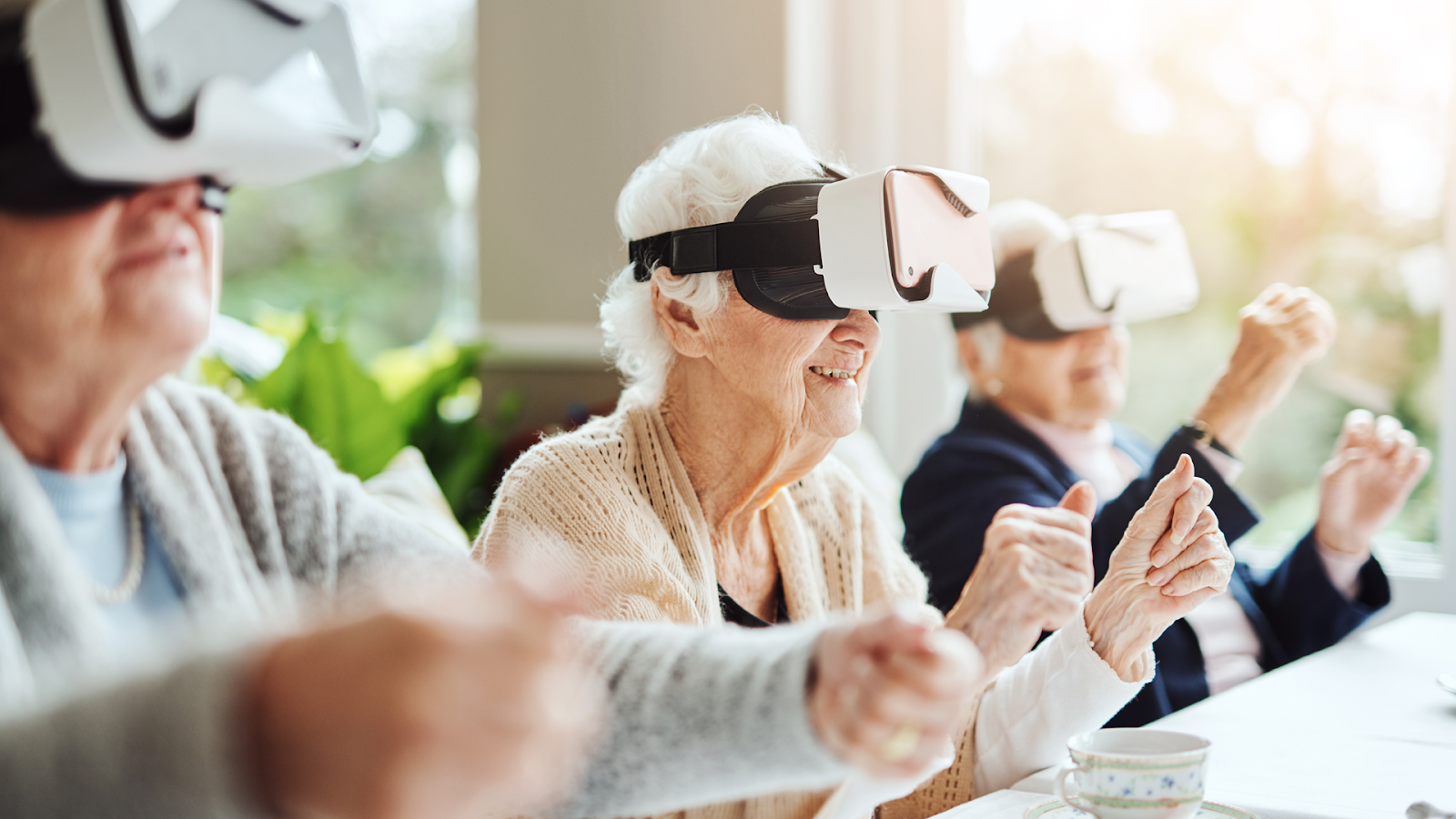
Imagine that you are playing an exciting computer game, gaining useful skills, go through new levels, study the game cards, get rewards, and the next day you go into the game again, but some of the skills are lost, the levels need to be completed, the cards have already changed and some awards were selected. You restore lost achievements, move a little further, and the next day you roll back again. And so every time. Moreover, gradually your kickbacks exceed the advancement - in the end, you are already at the very beginning, do not remember what you went through, and do not even know how to play. Something like this happens in real life in people diagnosed with Alzheimer's disease (AD).
Briefly about Alzheimer's disease
It is a neurodegenerative disease characterized by cognitive impairment, the development of dementia, social maladjustment, and reduced life expectancy. Pathophysiological changes characteristic of AD begin years and even decades before clinical confirmation of the disease.

Shot from the film "Diary of Memory"
Diseases are more susceptible to elderly people, although in rare cases it can manifest itself much earlier. Moreover, the further over 60, the greater the likelihood of developing the disease. This is probably why there is a widespread belief that Alzheimer's will come to everyone, just not everyone will live to see it.
At first, the disease manifests itself in subtle symptoms, which are often confused with a stress response or ordinary aging. For example, people may find it difficult to complete daily tasks or have difficulty absorbing new information and then remembering it. In the early stages, executive function problems, such as planning, focus, abstract thinking, may also begin to emerge. Early AD symptoms are also referred to as so-called Mild Cognitive Impairment (MCI). At this time, apathy often occurs, which becomes the most persistent symptom of the disease. Over time, there is a loss of long-term memory, impaired speech and cognitive functions, destruction of brain tissue, which entails the patient's inability to independently exist in the surrounding world.

Neurodegeneration of brain tissue in Alzheimer's disease
It is still unclear what is the root cause of the onset of Alzheimer's disease, and currently there are no treatment methods, even stopping the disease has not yet been possible. However, if the predisposition to asthma is determined 10 years before the onset of the first symptoms and additional development of cognitive and motor functions begins, it is possible to significantly extend the life of a sane mind and mitigate the manifestations of the disease! Here the question immediately arises: how to diagnose in advance the possibility of AD development and what to do after that?
Neurophysiological methods
More and more attention is paid to neurophysiological methods that allow detecting cognitive impairments at the functional level long before they become noticeable to others or the patient himself. Thus, neurophysiological studies of recent years have shown that changes in the brain's responses to a presented sound stimulus - event-related potentials ( ERP ) - make it possible to accurately detect the risk of AD development over the next 10 years.

ERP registration procedure
Knownthat hearing loss can occur in the earliest stages and be a harbinger of the development of dementia. Moreover, there is also a feedback here: the more significant the problems with hearing, the more a person spends efforts to make out what they are told and remember it, which means that large structural changes occur in the brain, leading to the development of AD. Studies in the oddball paradigm with sound stimulation, where the subjects need to quickly and accurately distinguish signals of two different frequencies, have shown that an increase in latency (latency) and a decrease in the amplitude of such ERP components as N100, P200, N200 and especially P300 (you can read about the P300 here ), arising approximately 100, 200, and 300 ms after the presentation of the stimulus, respectively, signal a decrease in the functions of cortical processing (more details hereand here ) a decade before the manifestation of violations. In addition, the diagnostics using the ERP registration method showed a sensitivity of 87% and a specificity of 90% , which can be considered a fairly accurate method.
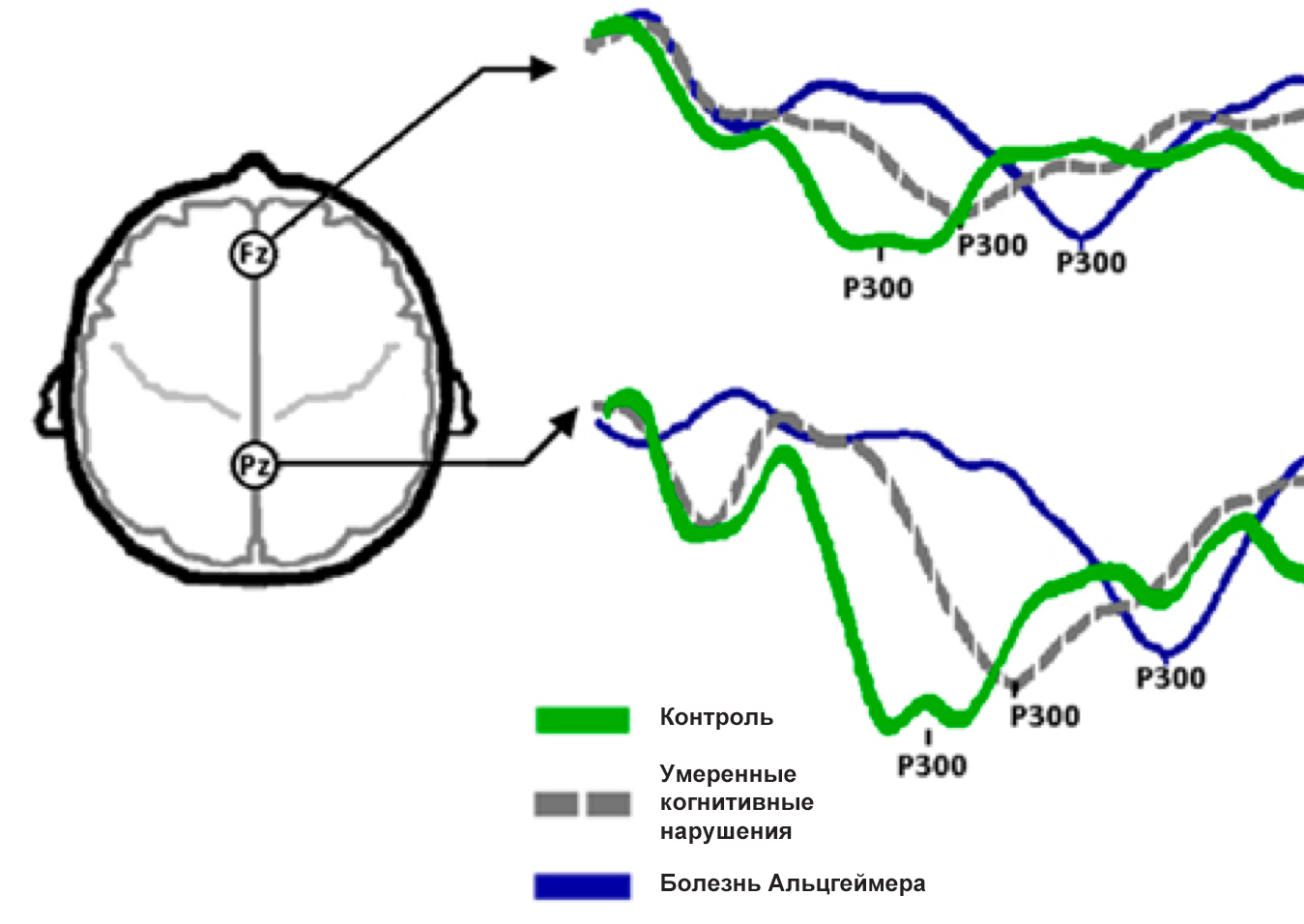
Changes in the characteristics of the P300 wave with MCI and BA
The most interesting thing is that such a survey can take only a couple of minutes and be very easy to pass. You just need to put on a cap with electrodes and register a signal from the brain while a person listens to different sounds. It is many times more comfortable, easier and faster than performing tomography ( PET , MRI ) and cognitive tests, and even better as a preventive method.
BCI rehabilitation
Neurophysiological methods not only allow detecting disorders in the functioning of brain regions, but also provide an opportunity for their effective restoration. This is just about the now popular BCI (brain-computer interfaces), or in Russian - brain-computer interfaces, they are also neurointerfaces. Let me remind you that this technology is based on detecting a specific signal of brain activity and converting it into commands for controlling various devices (you can read more here ).
BCIs have already established themselves as an excellent tool for the rehabilitation of people with motor impairment after stroke, paralysis and plegias, traumatic brain injury, ADHD, autism, including cognitive impairment and dementia.
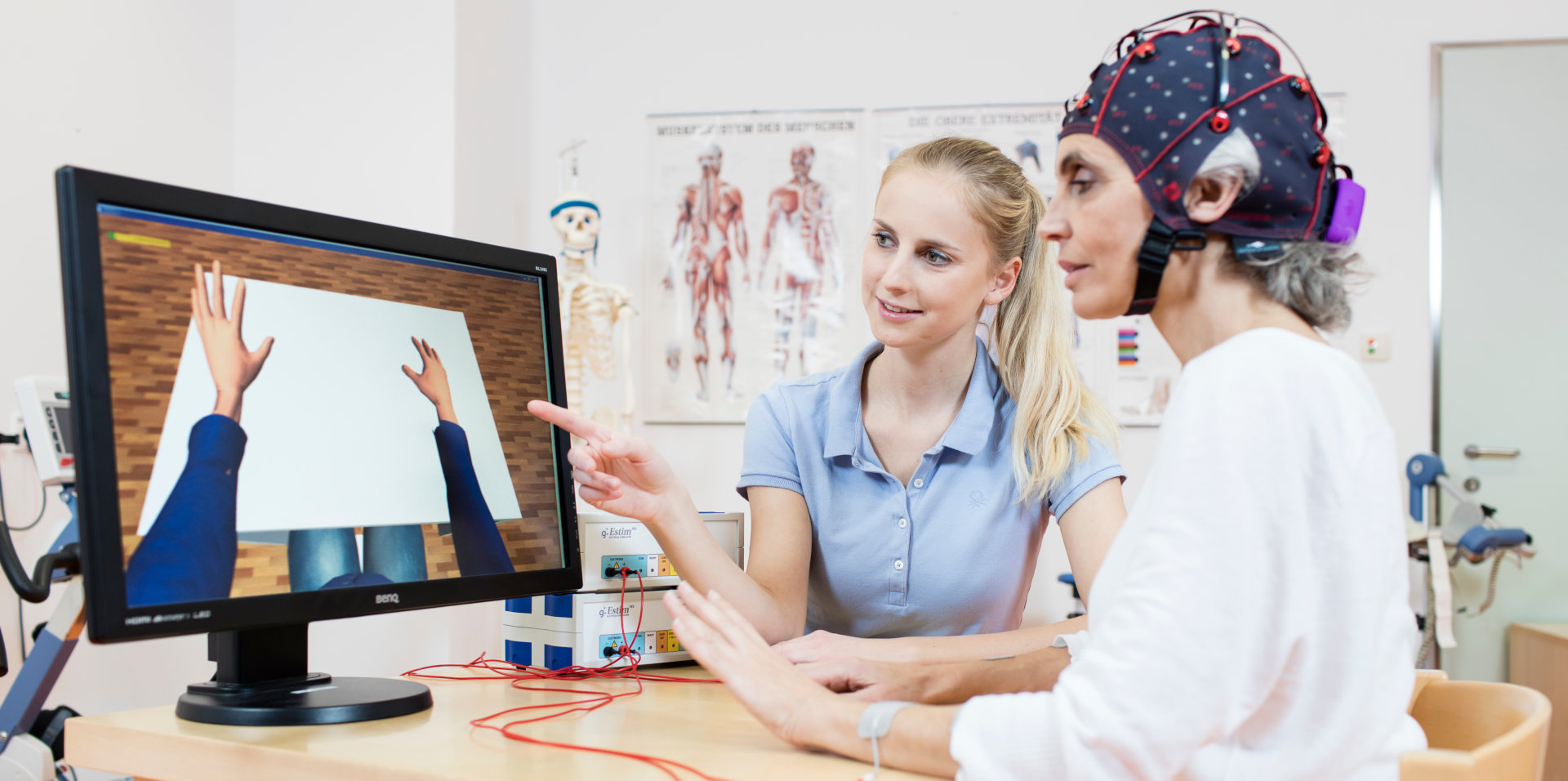
Neurorehabilitation based on motion representation
BCI EEG has a number of advantages over other rehabilitation methods:
- ease of use (just put on a hat);
- high efficiency;
- activation of neuroplasticity.
But there are a number of limitations:
- some methods take time to learn how to work with them (presentation of movement, rhythms);
- training conditions are far from real life events (flashing pictures on the screen, boat control);
- many systems used in clinics cause discomfort to the patient (wet hats, a bunch of electrodes, gel in the hair, long installation).
BCIs have also been shown to be effective in Alzheimer's patients. For example, the review shows the possibilities of using ERP and SMR (sensorimotor rhythm) to improve cognitive functions of attention, spatial orientation and short-term memory.
VR rehabilitation
Another promising method for working with Alzheimer's is VR. The main advantage of VR is, of course, the freedom to create any environment and control conditions! For example, according to the results of a study at the early stages before the first symptoms of Alzheimer's disease appeared, scientists were able to achieve the highest accuracy (sensitivity 100%, specificity 98%) in diagnosing the disease when completing tasks in a virtual museum. No scary and unpleasant sampling of cerebrospinal fluid (lumbar puncture), tomographs (PET and MRI), but just a VR helmet.
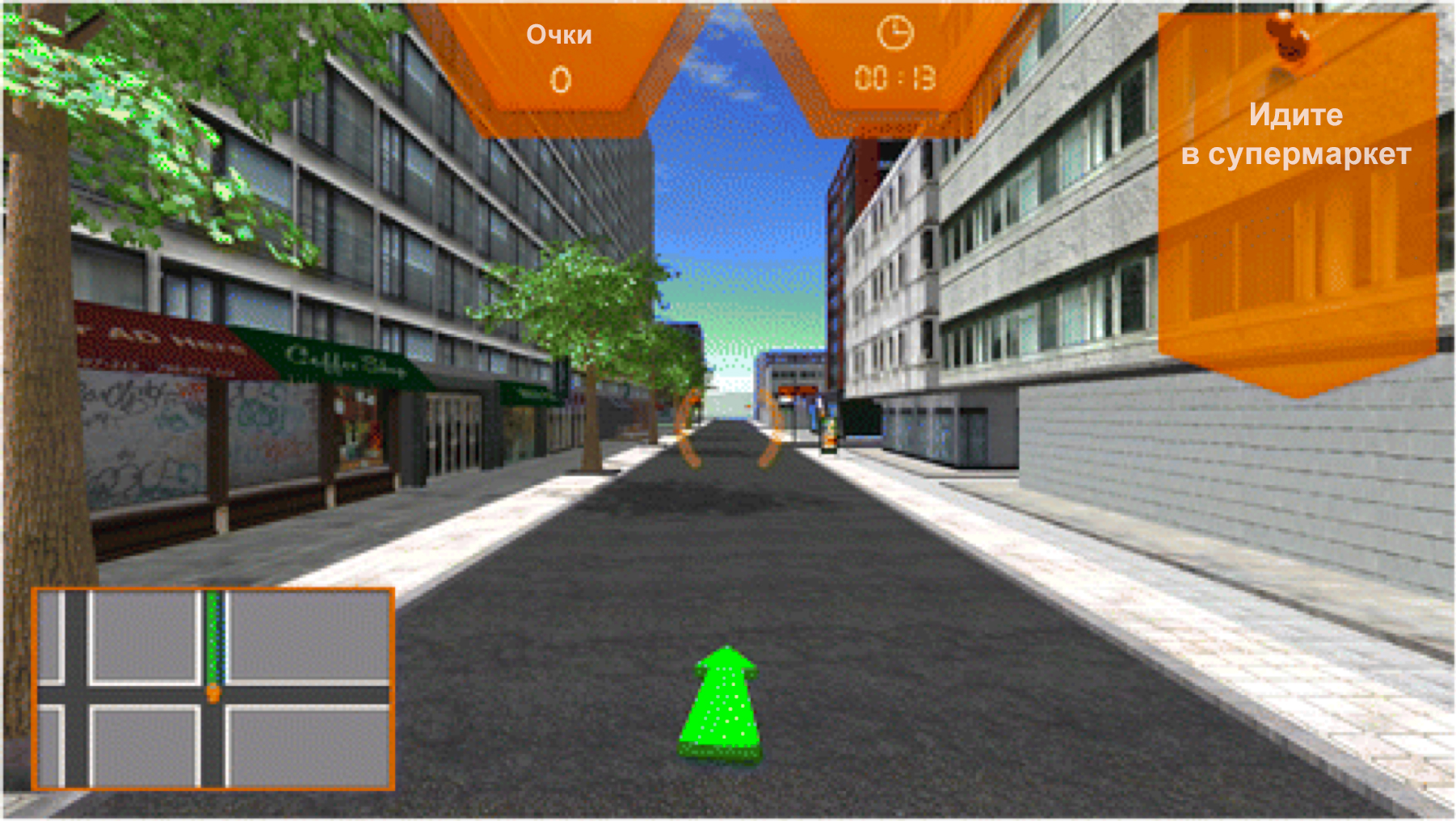
Spatial orientation
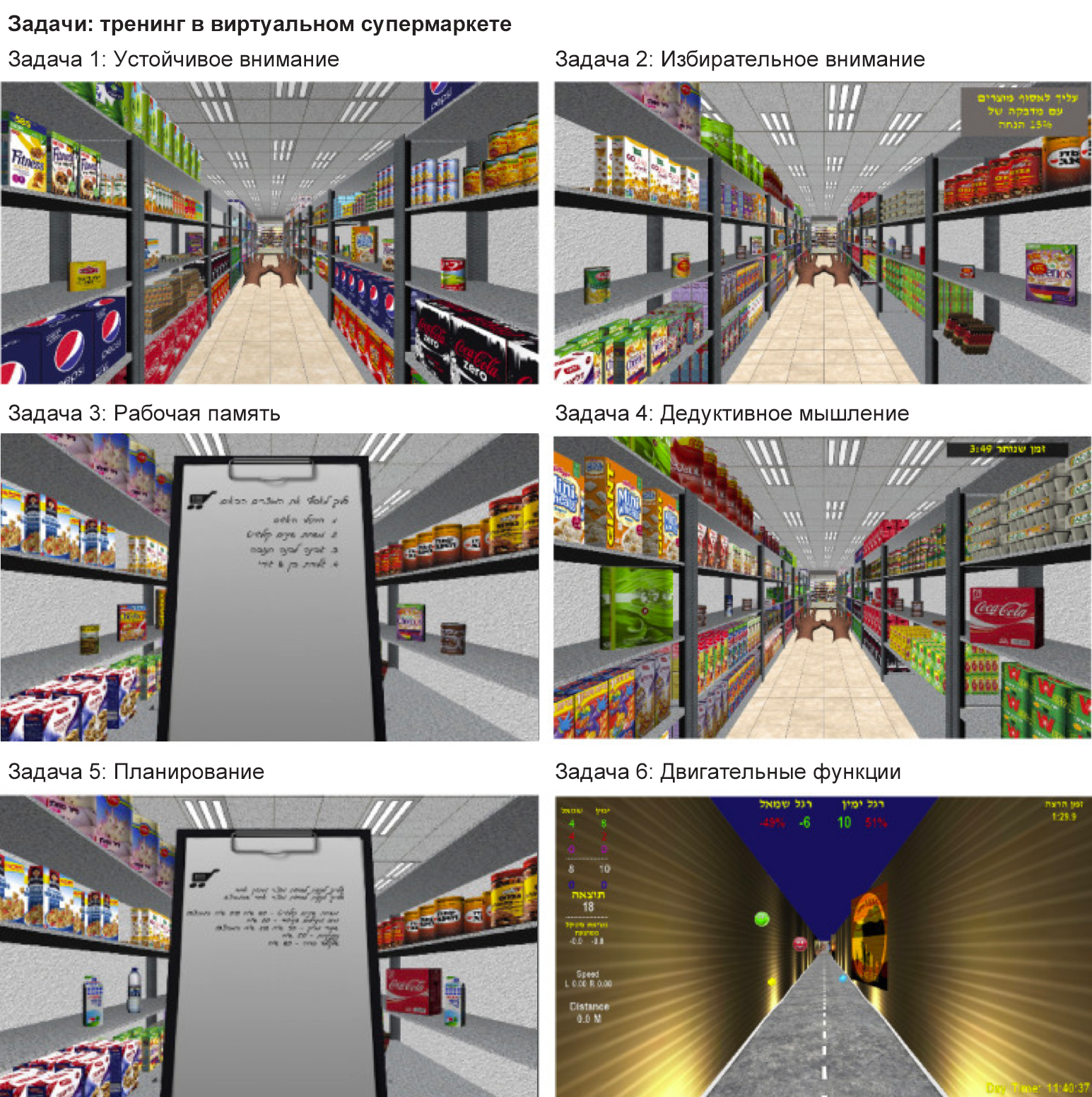
training Training in the virtual store
The use of virtual reality makes it possible to reveal quite accurately and early violations of spatial and episodic memory, executive functions and attention, motor functions and balance, and the fulfillment of everyday tasks. Moreover, studies have shown that training in VR, which is a simple game task for the user in a variety of conditions, can significantly improve all these functions in people with AD (you can read here ).
Artificial intelligence and Alzheimer's
And of course, we will not bypass such a method of early diagnosis as the use of artificial intelligence (AI) and machine learning based on data of various modalities. With what they did not combine them, what data did not feed the algorithms for training, and after all, they achieved good results!
This article on Habré tells about a study where it was possible to recognize 98% of cases of the disease development 6 years before the onset of symptoms using PET images using AI.
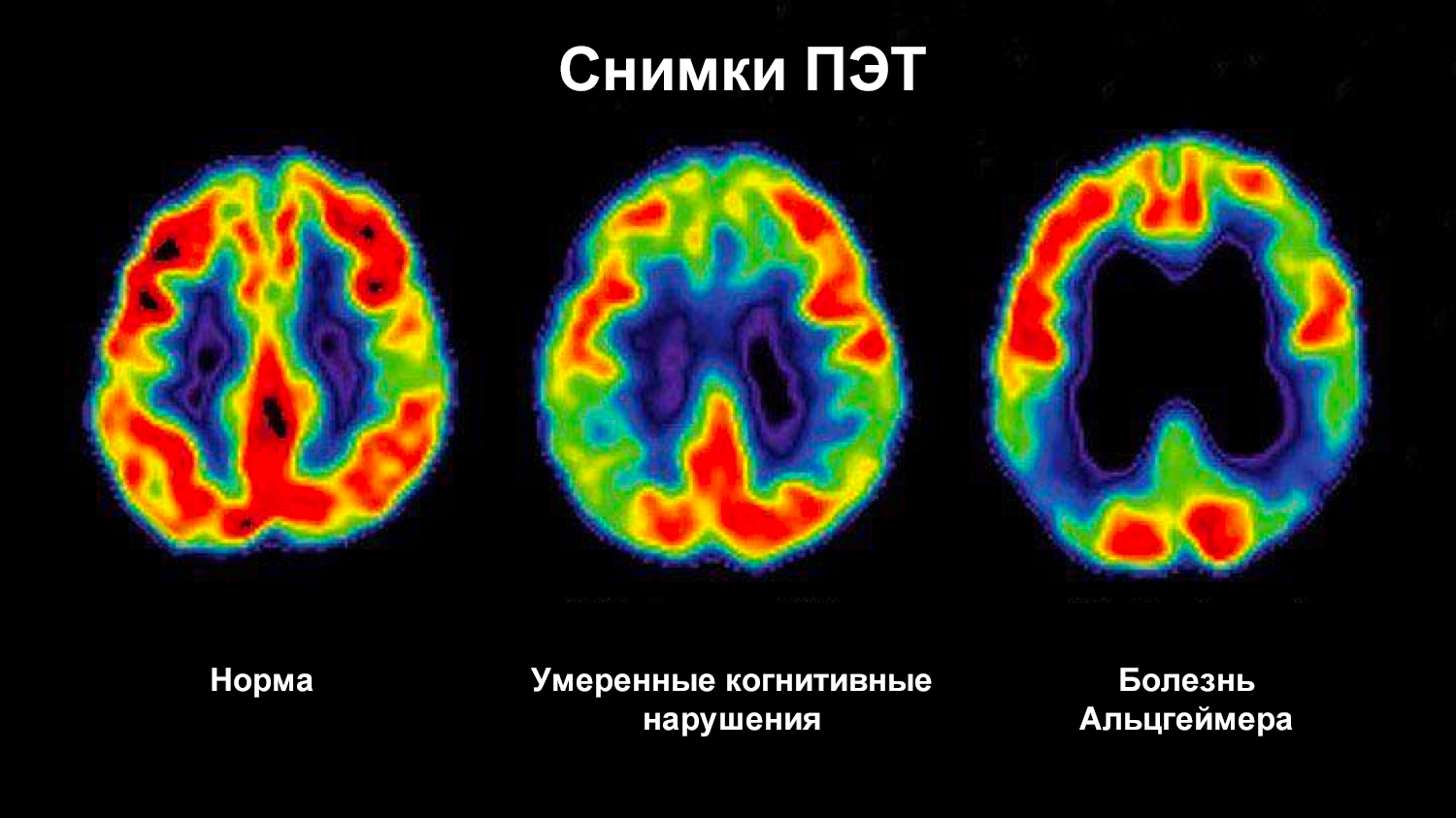
Brain changes on PET
scans AI is widely studied for diagnosing Alzheimer's disease on MRI scans. So, they showed the possibility of detecting a disease in the early stages with an accuracy of 88%, and in this studywith an accuracy of 98.9%, the AI determined in which of the patients with MCI the disease progresses to Alzheimer's.
Combinations of machine learning with EEG data also did not stand aside. In just a few minutes of EEG recording in a calm state, the I-FAST method was able to distinguish Alzheimer's patients from MCI with an accuracy of 94–98% and MCI patients from healthy ones with 98.25%.
Cherry on the cake - BCI + VR + AI
Now let's imagine that we took all the best from BCI, the best from VR, and combined it with AI into a single system! And now we got the earliest possible detection of neurodegenerative changes and neurorehabilitation in absolutely any VR conditions! If you want, recreate incidents from real life (shop, museum, apartment ...), if you want, do an exciting game or anything that helps restore cognitive functions.

Training of neurocontrol in virtual reality
Research, comparing the effectiveness of BCI when working with a monitor and in VR, showed that when combined with the latter, user engagement increases by as much as 10%, which is already quite significant, although there was a fairly simple visualization. The BCI-VR combination has already been successfully used to rehabilitate post-stroke patients with SSVEP and motion representation , patients with plegias , autism and ADHD , and to maintain normal cognitive levels in the elderly.... EEG recording during training in VR will also allow detecting changes in the patient's cognitive functions and emotional response in real time, adapting the training for a more comfortable and efficient passage.
While combining BCI, VR, and AI looks promising from all angles, there is still very little research combining these techniques. Recently, Impulse Neiry began developing a fast, convenient and effective method for diagnosing Alzheimer's disease, mild cognitive impairment, dementia and early cognitive impairment, as well as training to maintain cognitive and motor function in the presence of the disease. There are plans to create interesting game content for diagnostics, monitoring and rehabilitation in medical centers and at home.
Can you avoid it?
If you have read this far and nevertheless decided that you do not want to be in the care of medical workers at the age of 60-70, not to understand where you are and who all these people are around, then now you should actively develop your cognitive functions by any possible methods , whether it's reading books, doing crosswords, board games or something more interesting like cognitive training ( Neiry , CogniFit and others). Also, let's not forget about healthy eating and daily physical activity and mobility.

All health and many years of sane!